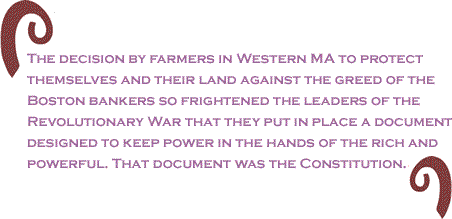| Dear
Supporters,
By
the 1980s, it was clear to me that my goals for Black social
and economic liberation could only be achieved by developing
a framework of economic democracy and economic rights that
would provide a foundation for the liberation of all of
our citizens.
The
experience of slavery and its denial of humanity created
a horror for Africans in this country not experienced by
others. Yet, as I studied the history of this country, it
became clear that “the founding fathers - white men of property”
had cleverly created a system that kept everyone in a state
of economic servitude except themselves.
However,
it was not until a warm summer day in 1984 that I realized
that the decision by farmers in Western MA to protect themselves
and their land against the greed of the Boston bankers so
frightened the leaders of the Revolutionary War that they
put in place a document designed to keep power in the hands
of the rich and powerful. That document was the Constitution.
Ironically,
this revelation took place on a trip to western MA on behalf
of the Industrial Cooperative Association to meet with a
group of carpenters interested in forming a company that
they would own cooperatively. On the way to the meeting,
I  noticed
a small wooden sign by the side of the road outside of Great
Barrington. My organizer curiosity prompted me to stop the
car to see what motivated someone to put this sign no taller
than a foot by the side of this country road. noticed
a small wooden sign by the side of the road outside of Great
Barrington. My organizer curiosity prompted me to stop the
car to see what motivated someone to put this sign no taller
than a foot by the side of this country road.
My
curiosity grew even greater when I read the inscription
on the sign that said that the last battle of the Revolutionary
War was fought here in 1786. Knowing that the Revolutionary
War ended officially in 1783, I was not only curious but
confused. After the meeting with the carpenters, I asked
whether anyone could tell me what the sign said. A couple
of the men smiled and said to others, “Apparently he doesn’t
know our history”.
As
a Harvard grad (1963) and a student of history, I thought
I was well educated, particularly about the formation of
this country. However, that afternoon, as they proceeded
to tell me about Captain Daniel Shay and the Regulators,
I
learned how much I didn’t know about the history of this
country and its founding.
Let
me briefly share what I learned that afternoon and have
added to over the years. After the Revolutionary War, farmers
in central and western MA who had joined Massachusetts militia
to fight for their economic and political freedom from England
returned to their land. However, while the British were
no longer present to terrorize and exploit them, the Boston
bankers were seizing their land through the foreclosure
process.
Pressured
to pay off debts resulting from the war, the Mass legislature
began to enact a variety of taxes that fell heavily on the
small farmers. When unable to pay, their lands and goods
were confiscated and if unable to pay the entire debt, the
farmers were then put in debtor prison.
Having
fought only a few years before to end British tyranny, the
farmers began to organize to confront courts and judges
to suspend the foreclosures and confiscation until the legislature
acted. But the legislature rejected their demands for reduction
of taxes, the issuance of paper currency, and other measures
that would relieve their crisis.
While
not granting relief to the farmers from the crisis, the
legislature under the leadership of Sam Adams, revolutionary
war hero and now MA Senate president, took action to crush
the “second revolution”. Not only was habeas corpus suspended
allowing the government to keep those arrested indefinitely
in jail but also the legislature passed the Riot Act, authorizing
the execution of those who challenged the government.
Feeling
that they had no alternative, the farmers continued to organize
and confront courts in Worcester, Northampton, and Springfield,
and recruited Captain Daniel Shay, son of Irish immigrants,
small farmer, and popular Revolutionary War leader to lead
their rebellion.

While
Shay believed that action had to be taken, he also believed
that they needed to avoid blood shed and focused on negotiations.
In August of 1786, Shay led over 1000 men to the Springfield
Court House where the Supreme Judicial Court was preparing
to issue indictments against some of the farmers arrested
in earlier confrontations. Through negotiations he and
his fellow Regulators were able to persuade the Court to
end their session without issuing indictments.
Despite
this partial victory, the confrontations continued at courthouses
in central and western MA and the attacks on the people
by the militia continued to intensify. By December, Shay
and the movement leadership decided that to sustain themselves
and their struggle they needed arms and supplies and decided
to march on the Springfield Armory.
Shay
initially believed that they would be able to negotiate
a government withdrawal from the army given an “army” of
nearly 2000 farmers and townspeople who had been recruited.
Unfortunately, the MA militia fired on Shay and his troops
who were not able to hold and fled to Petersham where they
were again attacked and crushed a month later ending Shay’s
rebellion.
However,
inspired by the actions of Shay and his troops, similar
uprisings were taking place in other states. Frightened
by the fact that “citizens” were taking the idea of freedom
from economic tyranny seriously, there was a call for a
Constitutional Convention to be held in Philadelphia with
representatives to be selected by the state legislatures.
The
declared purpose of the Convention was to consider amendments
to the Articles of Confederation; however, Alexander Hamilton,
James Madison, and others saw it as the opportunity to over
turn the Confederation and develop a Constitution that would
create a centralized government and standing army capable
of protecting the interests of the oligarchy. While only
39 of the original 62 appointees signed the final draft,
by 1789 the nine states necessary for ratification had adopted
the Constitution and the oligarchy had put in place the
protections needed to build their dynasty.
My next article in this series will be “Civil Rights
without Economic Rights makes Constitution a Tool for Oligarchic
Control”.
Click
here to
read any of the commentaries in this series.

BlackCommentator.com Editorial
Board Member Chuck Turner - Served as a member of the Boston City Council for ten years
and eleven months. He was a member and founder of the Fund
the Dream campaign and was the Chair of the Council’s Human
Rights Committee, and Vice Chair of the Hunger and Homelessness
Committee. Click
here to contact Mr. Turner.
|

